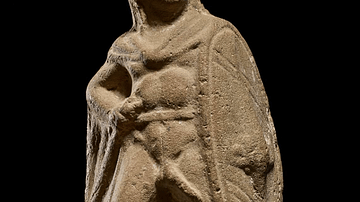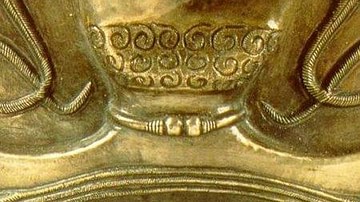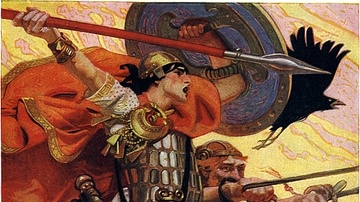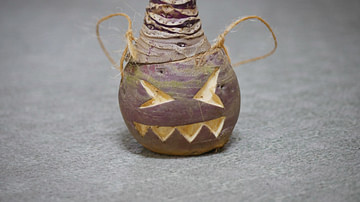
The Mórrigan (also Morrighan, Môr-Riogain or Morrigu), usually referred to with the definite article, was a great warrior-queen goddess in Irish-Celtic mythology. She was most associated with inciting war, then stirring up the fury and frenzy of battle, and finally, as the bringer of death. The goddess was able to take any form of living creature she wished and she helped bring about the demise of the hero-warrior Cú Chulainn after he spurned her many attempts to seduce him as different animals. Her coupling with the Dagda, another major warrior-god, was an important part of the Samhain festival which the Celts celebrated to mark the beginning of a new year.
Names & Associations
The name Mórrigan, which may have several variations of spelling, means 'great queen', 'phantom queen', 'queen of nightmares' or, more literally, 'mare-queen'. She may have evolved from the ancient territorial goddess Mór Muman who was associated with the sun and kingship in southern Ireland. She is a war-goddess, and she is particularly associated with the fury of war, hence her 'demonic' nature and another name by which she is sometimes known, the 'queen of demons'.
Mórrigan is closely associated with two other war-goddesses: Badb and Macha (or alternatively Nemain). This trio is collectively known as the Mórrigna. Some scholars suggest that the trio of goddesses are simply different aspects of the Mórrigan as the triple aspect of gods is a common theme in Celtic religion which emphasises the potency of deities. Appropriately, then, all three goddesses are the daughters of Ernmas, the great mother deity, and their father is, in some tales, the sorcerer god Cailitin. The Mórrigan has one son, the evil figure Mechi, who has three hearts, each of which contains a serpent. Mechi's father is not named.
The Mórrigan has a terrible appearance, and it is this and her aggression which have a strong psychological effect on whoever she chooses during a battle. At the same time, the goddess can be sexually attractive. Consequently, the Mórrigan is both a symbol of destruction and fertility. The goddess has certain powers such as being able to predict the future and to cast spells. Even more impressive, she can change her form at will and become a beautiful young girl, the wind, or any animal, fish or bird. The creature she is most connected with is the crow or raven, which the Celts associated with war, death, and inciting conflict. This aspect of the Mórrigan may well be the origin of the banshee, a female fairy that figures in later Irish and Scottish mythology. The banshee foretells death in a household by letting out a loud plaintive wail and, though she is rarely seen in physical form, when she is, she is an old woman with long white hair.
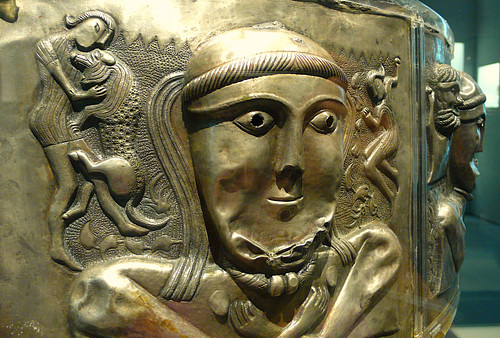
Another figure from Celtic folklore (in Ireland, Scotland, and Brittany) associated with the Mórrigan is the 'washer at the ford'. This figure, sometimes envisaged as a young and weeping female, at others, an old and ugly woman, was considered an omen of death as she would make certain clothes being washed in a river ford the colour of blood. Whoever's clothes were thus marked was thought to be in imminent danger.
When dwelling in this world, the Mórrigan's home was thought to be a cave in County Roscommon in northwest Ireland. This cave was known as the cave of Cruachan and the 'Hell's Gate of Ireland' since it was believed to be a passage to the Otherworld. In one myth, the Mórrigan lures the woman Odras to her cave by having one of her cows stray inside. The goddess then changes the hapless mortal into a pool of water. Cruachan was regarded as the seat of ancient kings of Connacht and has been identified as part of the group of archaeological sites at Rathcroghan in County Roscommon.
Samhain: Mórrigan & Dagda
In the religion of the ancient Celts, the Mórrigan was a prominent figure in the festival of Samhain (aka Samain) which was held on 1 November. The festival celebrated the end of the old year and the beginning of the new. This was also a time when the spirits of the Otherworld could be best contacted and so there were also certain traditions on the eve of Samhain, the 31st of October. If the Mórrigan and the warrior-god the Dagda came together at this time then their sexual union would guarantee the fertility and prosperity of the tribe and its harvests and livestock in the coming year. In the imagination of the myth-writers, the Mórrigan was stood astride the River Unshin (aka Uinnius) near Ballymore in County Sligo and busy washing herself when she was accosted by the Dagda. In other versions, the Mórrigan appears as an old hag but, after coupling with the Dagda, she is transformed into a young and beautiful woman.
The Battle of Mag Tuired
The Dagda was also a warrior-leader of the Tuatha Dé Dannan, the pre-Christian Irish gods or supernatural race who brought elements of civilization in the Irish Mythological Cycle. The invasion of the Tuath Dé Dannan is told in the Cath Maige Tuired (aka 'The Battle of Mag Tuired'), an 11th-century CE text which collated earlier sources. Another source is the 11-12th-century CE Lebor Gabála Erenn ('Book of Invasions'). The invaders are victorious against the current inhabitants, the Fir Bolg at Mag Tuired, a plain in Connacht in northwest Ireland. Then there is a second battle between the Tuatha Dé Dannan and the Fomorians, who are either semi-divine beings or demonic pirates. The Mórrigan warns the Dagda when the Fomorians plan to attack. She intervenes more directly by distracting and exhausting the Fomorian warrior Indech, who is then killed by Lugh, another leader of the Tuatha Dé Dannan. In a more graphic version of events, the Mórrigan butchers Indech herself and hands out great handfuls of his blood to the horrified Fomorian warriors looking on.
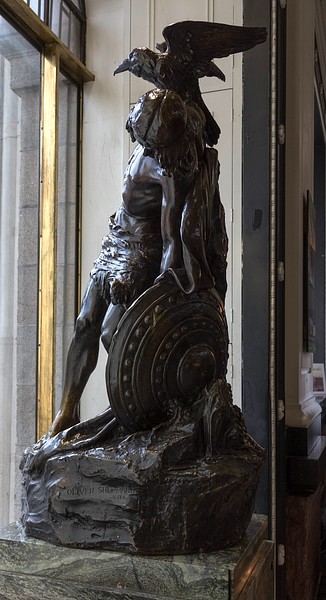
The Mórrigan & Cú Chulainn
The 7-8th-century CE epic poem Táin Bó Cuailnge ('Cattle Raid of Cooley') tells of a raid on Ulster by an army from Connacht to steal a sacred bull, Donn Cuailnge, and the efforts of the warrior-hero Cú Chulainn, who holds off the invading army single-handedly. In this text, the Mórrigan is an enemy of the Tuath Dé Dannan and, in particular, Cú Chulainn. The Mórrigan appears before the hero as a beautiful young woman and tries to seduce him, but he rejects her advances. The hero famously states that he "does not have time for women's backsides" (in Mackillop, 336). Not at all put off by this rebuff, the Mórrigan repeatedly tries to seduce the hero, each time taking on the form of a different creature but each time being rejected. Appearing as an eel, Cú Chulainn breaks its ribs, when a wolf, he knocks out one of its eyes, and as a heifer without horns, he breaks one of its legs.
The Mórrigan does not forget this treatment and later appears as an old cow. She informs the hero his death will occur when her calf from her heifer incarnation becomes one year old. Then, as Cú Chulainn fights for his life in a duel with Lugaid mac Con Roi, the Mórrigan first breaks the wheels of Cú Chulainn's chariot and then appears as an old crone milking a cow. The hero is exhausted with fighting, and the goddess offers him a drink of milk which he accepts and so he is rejuvenated. The Mórrigan's final appearance is as a hooded crow on the hero's shoulder which indicates his impending doom. Cú Chulainn is then decapitated by Lugaid mac Con Roi. The Mórrigan then was indeed a fearsome figure, and when she appeared as the crow of death, not even a hero could escape their mortal destiny.
